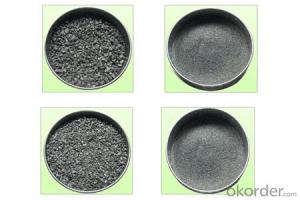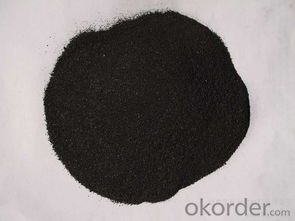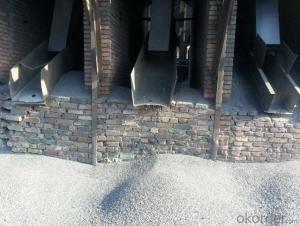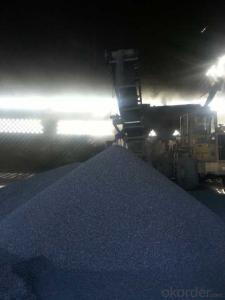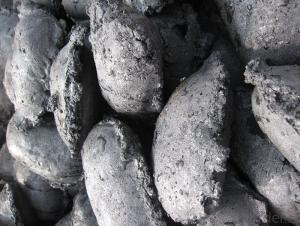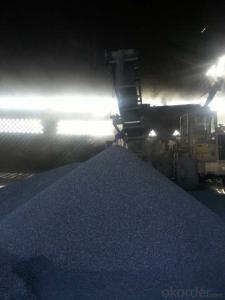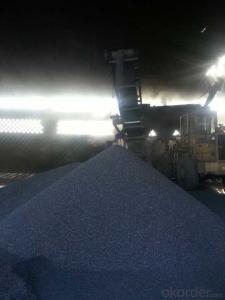FC93 RecarburIzer With High Purity And Good Service CNBM
- Loading Port:
- Tianjin
- Payment Terms:
- TT OR LC
- Min Order Qty:
- 0 m.t.
- Supply Capability:
- 100000 m.t./month
OKorder Service Pledge
OKorder Financial Service
You Might Also Like
Packaging & Delivery
Packaging Detail: | 25kgs/50kgs/1ton per bag or as buyer's request |
Delivery Detail: | Within 20 days after receiving corect L/C |
Specifications
Calcined Anthracite
Fixed carbon: 90%-95%
S: 0.5% max
Size: 0-3. 3-5.3-15 or as request
Feature
All of our goods are made in the best quality of world famous Tianjin. All of our products are with High carbon, Low ash, low sulphur, Low Moisture.
Application
The Calcined Anthracite Coal/Gas Calcined Anthracite Coal/Carbon Raiser is mainly used in steelmaking in electrical stove, screening water, shipbuilding sandblast to remove rust. It can reduce the cost of steelmaking effectively by replacing the traditional petroleum coke of carburant.Also can improve the Carbon content in steel-melting and Ductile iron foundry.
Specifications
Calcined Anthracite
Fixed carbon: 90%-95%
S: 0.5% max
Size: 0-3. 3-5.3-15 or as request
PARAMETER UNIT GUARANTEE VALUE | |||||
F.C.% | 95MIN | 94MIN | 93MIN | 92MIN | 90MIN |
ASH % | 4MAX | 5MAX | 6MAX | 7MAX | 8MAX |
V.M.% | 1 MAX | 1MAX | 1.5MAX | 1.5MAX | 1.5MAX |
SULFUR % | 0.5MAX | 0.5MAX | 0.5MAX | 0.5MAX | 0.5MAX |
MOISTURE % | 0.5MAX | 0.5MAX | 0.5MAX | 0.5MAX | 0.5MAX |
Size can be adjusted based on buyer's request.
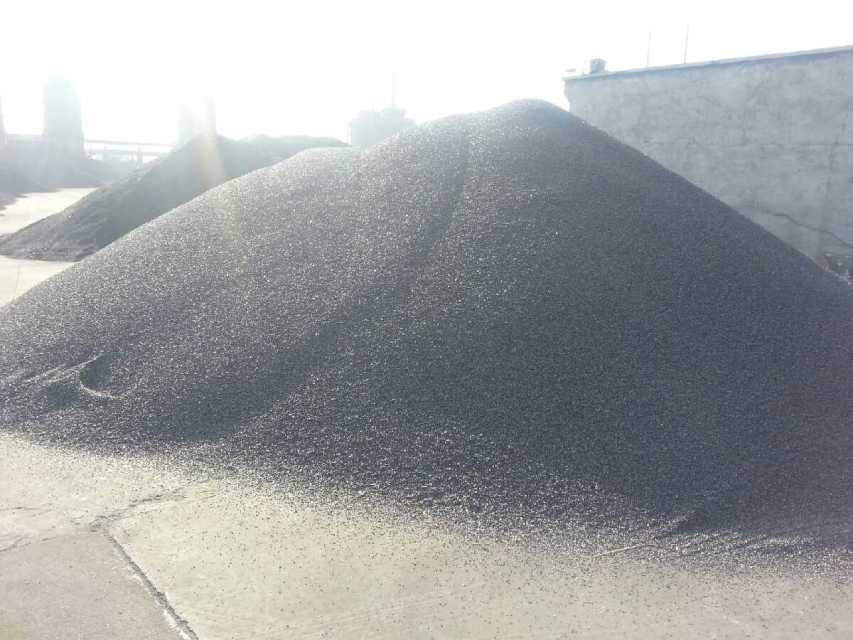
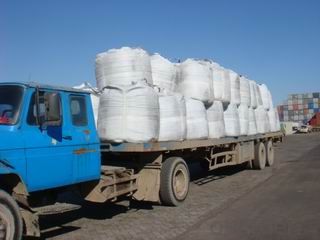
- Q: What is the density of carbon steel and alloy steel?
- Chromium molybdenum aluminum steel 7.65Tungsten 9 high speed tool steel 8.3Tungsten 18 high speed tool steel 8.7High strength alloy steel 7.82Bearing steel 7.81Stainless steel 0Cr13, 1Cr13, 2Cr13, 3Cr13, 4Cr13, Cr17Ni2, Cr18, 9Cr18, Cr25,, Cr28 7.75Cr14, Cr17 7.70Cr18Ni9, 1Cr18Ni9, Cr18Ni9Ti, 2Cr18Ni9 7.851Cr18Ni11Si4A1Ti 7.52Stainless steel 1Crl8NillNb, Cr23Ni18 7.92Cr13Ni4Mn9 8.53Cr13Ni7Si2 8
- Q: What is the role of carbon in the formation of diamonds?
- The role of carbon in the formation of diamonds is crucial as it is the sole element responsible for the creation of these precious gemstones. Diamonds are formed deep within the Earth's mantle, under extreme pressure and temperature conditions. Carbon atoms, when subjected to immense pressure and heat, undergo a process called graphitization, where they rearrange their atomic structure and transform into a crystal lattice arrangement, giving rise to the formation of diamonds. The process starts with carbon-rich materials, such as organic matter or carbon-bearing minerals, being exposed to the intense heat and pressure found deep within the Earth's mantle, typically at depths of around 150 to 200 kilometers. Under these conditions, the carbon atoms within these materials are forced to bond together in a unique way, forming the rigid, three-dimensional lattice structure characteristic of diamonds. The formation of diamonds requires specific geological conditions, including temperatures above 900 degrees Celsius and pressures exceeding 725,000 pounds per square inch (50,000 atmospheres). These extreme conditions are typically found in areas where ancient tectonic plates collide or in volcanic eruptions that bring diamonds to the Earth's surface. Carbon's ability to form strong covalent bonds with other carbon atoms is what allows the transformation into diamonds. Each carbon atom forms four strong covalent bonds, creating a tetrahedral structure. This strong bonding allows diamonds to possess exceptional hardness, making them one of the hardest substances known to man. In summary, carbon plays an essential role in the formation of diamonds, undergoing graphitization under immense pressure and temperature conditions to create the unique crystal lattice structure that gives diamonds their extraordinary properties. Without carbon, the formation of diamonds as we know them would not be possible.
- Q: Why is the longer the carbon chain, the better the hydrophobic properties?
- The carbon chain is the water chain, but the lower the polarity (TA)They have to write fifteen characters ah from702853 (station link TA) can theoretically explain it zhoupeng87 (station link TA) should be the basic alkyl is not hydrophilic, it belongs to the hydrophobic group, the increase of carbon chain length of the hydrophobic whyy0113 (station TA) carbon chain is longer, the more polar groups easily entrapped nature shows hydrophobic alkane name small Jia (TA station) the carbon chain length of hydrophobic chain length, of course, hydrophobic. Cher (station TA) the alkyl chain is hydrophobic, so the longer hydrophobic part content more hydrophobic natural good red sandalwood fragrance (TA station).
- Q: What are the properties of carbon-based textiles?
- Carbon-based textiles have a number of unique properties that make them advantageous in various applications. Firstly, carbon-based textiles exhibit exceptional strength and durability. They are known for their high tensile strength, making them resistant to stretching and tearing. This property allows carbon textiles to withstand harsh conditions and maintain their integrity over time. Secondly, carbon-based textiles possess excellent thermal conductivity. They can efficiently conduct heat, making them suitable for applications that require effective heat management. This property is particularly useful in industries such as aerospace, automotive, and electronics, where heat dissipation is essential to prevent system failures. Furthermore, carbon textiles are highly resistant to chemical corrosion. They can withstand exposure to various chemicals, acids, and solvents without losing their structural integrity. This property makes carbon-based textiles ideal for applications in the chemical industry, where exposure to corrosive substances is common. Another notable property of carbon textiles is their inherent flame resistance. They have a high resistance to ignition and do not propagate flames easily. This characteristic makes them suitable for use in environments where fire safety is crucial, such as in protective clothing for firefighters and military personnel. Carbon-based textiles also exhibit good electrical conductivity, making them suitable for applications in electronics and electrical engineering. They can effectively conduct electricity and dissipate static charges, reducing the risk of electrical malfunctions or damage. Lastly, carbon textiles have a low coefficient of thermal expansion, meaning they do not expand or contract significantly with changes in temperature. This property makes them dimensionally stable, ensuring that they maintain their shape and size under varying thermal conditions. In summary, carbon-based textiles possess a combination of strength, durability, thermal conductivity, chemical resistance, flame resistance, electrical conductivity, and dimensional stability. These properties make them highly versatile and suitable for a wide range of applications in various industries.
- Q: What's the difference between coal and carbon?
- Coal has a certain luster, which contains a certain mineral oil, etc., is a relatively tight crystal structure. After baking coal coke, coal tar removal became less organized a lot of voids in carbon, most of which are carbon elements. Carbon produced by coal; also called coke. In addition, wood charcoal is also called charcoal.Coal and carbon can all be used as fuel. Most coal burns with smoke and may smell. Carbon burning generally does not have too much smoke, but also less odor.Carbon gap structure makes carbon have good adsorption, so carbon is often used as adsorbent material, used for adsorption of water, odor and so on.
- Q: How does carbon dioxide affect textile production?
- Carbon dioxide affects textile production in several ways. Firstly, the production of synthetic fibers such as polyester and nylon, which are widely used in the textile industry, involves the emission of carbon dioxide during the manufacturing process. This contributes to greenhouse gas emissions and climate change. Additionally, carbon dioxide is released during the combustion of fossil fuels used for energy in textile factories. This not only adds to the environmental impact but also affects air quality and human health. Moreover, the dyeing and finishing processes in textile production often require the use of chemicals that emit carbon dioxide when they break down or react with other substances. These emissions further contribute to the carbon footprint of the industry. Overall, carbon dioxide has a significant impact on textile production, primarily through the emissions generated during fiber manufacturing, energy consumption, and chemical usage. Therefore, efforts to reduce carbon dioxide emissions and transition to more sustainable practices are crucial for mitigating the environmental impact of the textile industry.
- Q: Recently bought an alarm clock, it is recommended to use carbon batteries. Nanfu battery is not good for the movement.
- Nanfu is generally alkaline battery, the alarm clock movement, the power is too large, will damage the movement. Supermarkets generally have many brands of carbon batteries, you can follow their favorite and ability to buy. There are deer, wild horses, PHILPS and so on.
- Q: Stability, primary carbon, two carbon, three carbon, four carbon
- From a variety of hydrogen is substituted alkyl free radicals generated in terms of difficulty order can have free radicals for the formation of tertiary carbon free radical secondary carbon free primary carbon free radicals. Alkyl radicals generated methyl easily, can be explained from two aspects: (1) different required to form free radicals when the fracture of C-H the energy, the (CH3) 3C-H fracture, the energy required for the smallest, most easily generated.
- Q: How does carbon affect the acidity of oceans?
- Carbon dioxide (CO2) is a major contributor to the acidity of oceans. When CO2 is released into the atmosphere through human activities such as burning fossil fuels and deforestation, a significant portion of it is absorbed by the oceans. This process, known as ocean acidification, leads to an increase in the concentration of hydrogen ions in the water, resulting in a decrease in pH levels and an increase in acidity. When CO2 dissolves in seawater, it reacts with water molecules to form carbonic acid (H2CO3). This reaction releases hydrogen ions (H+), which increase the acidity of the water. The increased acidity affects the delicate balance of chemical reactions that support life in the ocean, particularly those involving calcium carbonate. Calcium carbonate is a vital component in the formation of shells and skeletons of many marine organisms, including corals, shellfish, and some plankton. As the acidity of the ocean increases, it becomes harder for these organisms to build and maintain their calcium carbonate structures. This can lead to reduced growth rates, weakened shells, and increased vulnerability to predators and disease. Ocean acidification also affects the entire marine food web. Many species rely on shell-forming organisms as a food source or as habitat, and their decline can have cascading effects on the entire ecosystem. Additionally, acidification can disrupt the balance of phytoplankton, the microscopic plants that are the foundation of marine food chains. Furthermore, carbon dioxide in the ocean can react with water to form bicarbonate ions (HCO3-) and carbonate ions (CO32-). These ions are essential for maintaining proper pH levels and the ability of marine organisms to regulate their internal chemistry. However, as CO2 levels rise, the concentration of carbonate ions decreases, making it more difficult for organisms to access the carbonate they need to build their shells and skeletons. Overall, the impact of carbon on ocean acidity is significant and has far-reaching consequences for marine life. It is crucial to reduce carbon emissions and take measures to mitigate and adapt to the effects of ocean acidification in order to protect the health and biodiversity of our oceans.
- Q: How is carbon used in the production of activated carbon filters?
- Various industries and applications widely utilize activated carbon filters. These filters are utilized in water and air purification, gas masks, and even in the production of certain chemicals. The effectiveness of activated carbon filters heavily relies on the role of carbon in their production. Activated carbon, also referred to as activated charcoal, is a type of carbon that possesses a highly porous structure and a large surface area. The creation of this porous structure is achieved through a process known as activation. Activation involves subjecting carbonaceous materials, such as coal, wood, or coconut shells, to high temperatures in the presence of steam or specific chemicals. This activation process generates tiny pores and significantly increases the carbon's surface area. Consequently, the carbon becomes adept at capturing and eliminating impurities from gases or liquids. The activated carbon's high adsorption capacity attracts impurities like organic compounds, volatile organic compounds (VOCs), and certain heavy metals to its surface. In the production of activated carbon filters, the activated carbon is commonly molded into a granular or powdered state and then packed into a filter medium, such as a mesh or a cartridge. The filter medium functions as a supportive structure for the activated carbon, enabling the passage of air or water while effectively capturing and adsorbing impurities. Activated carbon filters excel at eliminating a wide array of contaminants, including chlorine, volatile organic compounds (VOCs), odors, and specific heavy metals. Consequently, these filters greatly enhance the quality of water and air by reducing pollutants and improving odor control. Furthermore, the versatility of activated carbon allows for customization based on the specific application. For instance, activated carbon can be infused with specific chemicals to heighten its adsorption capacity for particular contaminants. It can also be specially treated to target pollutants like mercury or arsenic. In conclusion, the utilization of carbon in the production of activated carbon filters stems from its porous structure and exceptional adsorption properties. These filters play a vital role in numerous industries and applications, effectively eliminating impurities from water and air, improving their quality, and ultimately benefiting environmental and human health.
Send your message to us
FC93 RecarburIzer With High Purity And Good Service CNBM
- Loading Port:
- Tianjin
- Payment Terms:
- TT OR LC
- Min Order Qty:
- 0 m.t.
- Supply Capability:
- 100000 m.t./month
OKorder Service Pledge
OKorder Financial Service
Similar products
Hot products
Hot Searches
